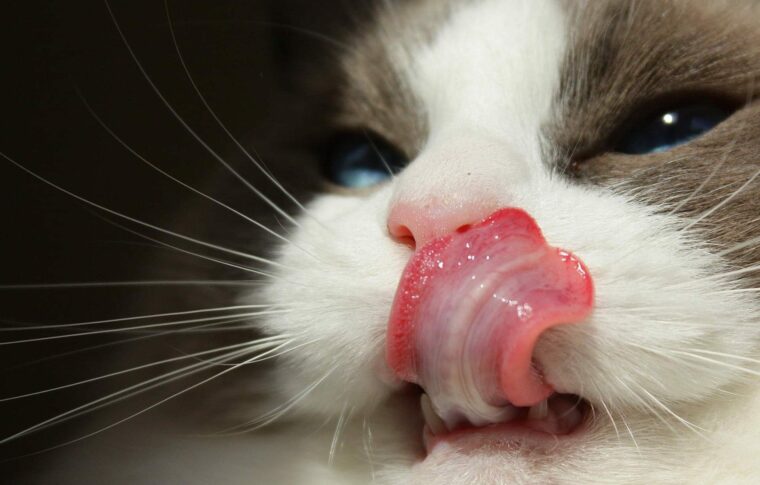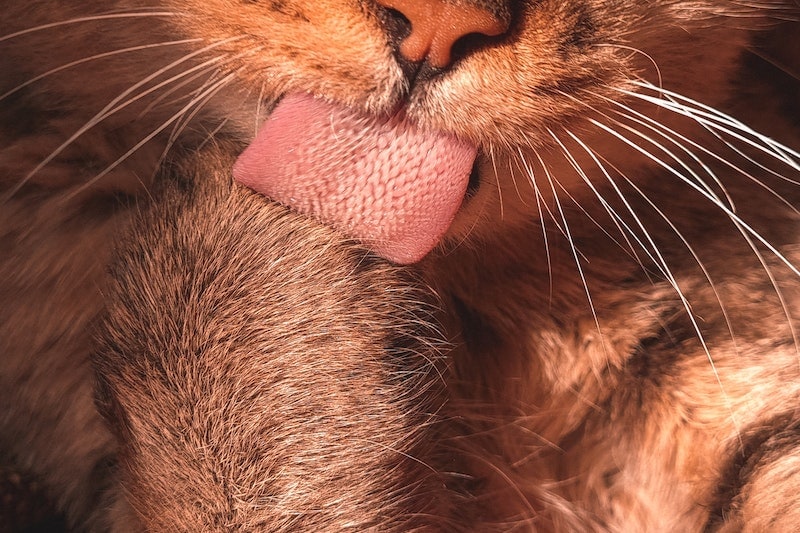
If you’ve ever been blessed with licking from a cat, then you know how rough their tongues are. As sweet as it is when your kitty gives you licks, it can get uncomfortable quickly because of just how rough their tongues really are. Have you ever wondered why cats have rough tongues, though? After all, dogs don’t have rough tongues. Or maybe you’ve always just assumed you knew the answer to the question of why cats have rough tongues. Either way, keep reading because the answer might surprise you! We will just say, that cats’ tongues are covered by keratin spines called filiform papillae, which make their surface rough.
 What Makes Cats’ Tongues Rough?
What Makes Cats’ Tongues Rough?
The science behind the roughness of cats’ tongues comes down to an evolutionary trait called filiform papillae. These tiny spines are formed from keratin, which is the same material that makes up hair and nails. In fact, if you magnify a cat’s tongue a few hundred times, you’d see that cats’ filiform papillae are shaped almost exactly like miniature versions of cats’ claws. All of the filiform papillae on your cat’s tongue point in the same direction, so if your cat were to lick you, it would feel rough, but if you ran your finger in the opposite direction across its tongue, then it would feel smooth.

Why Do Cats Have Rough Tongues?
If you had an idea in your head of why cats have rough tongues, it’s probably grooming related, right? Cats spend a huge portion of their waking hours, usually around 25–40%, grooming themselves, so it only makes sense that their tongue would serve a grooming function. If that was your guess, then you’d be right! Well, kind of. There are actually multiple reasons for cats to have rough tongues, and grooming is only a piece of the puzzle.
Helps with Hydration
The design of the filiform papillae on your cat’s tongue aids it in drinking water. If you’ve ever watched your cat drink, then you’ve seen that they dip their tongue into the water and then pull it back to their mouth rapidly until they’ve had enough to drink. Due to the shape of cats’ mouths, they can’t form mouth suction in the same way that humans can, so they fully rely on their tongues to drink. What happens when they dip the tip of their tongue in the water is that tension is created, allowing your cat to pull a small column of water to its mouth. Before the water tension breaks, your cat “bites” off the water column, leaving water behind in its mouth.
In case you were wondering, housecats average around four laps per second, and this number drops as cats are larger and larger. The biggest of the cats have a larger surface area on the tongue and filiform papillae, so their tongues are more efficient at getting water into the mouth. However, if you’ve ever watched a nature documentary showing lions or cheetahs in their natural environment, then you’ve likely noticed that they still lose quite a bit of water while drinking. This is because cats as a whole only bite off a portion of the water column they create.

Aids with Food Consumption (or Prey in the Wild)
The other reason that cats have rough tongues has to do with eating. Cats are obligate carnivores, so they require an almost exclusively animal-based diet. In the wild, the roughness of the tongue aids cats of all sizes in efficiently consuming prey. It allows them to lick bones clean, accessing all of the meaty goodness on the bones. You may not have noticed this when your cat catches a mouse because your cat is well fed and doesn’t have to hunt to survive. Wildcats, on the other hand, will eat as much of their prey as they can, often storing away pieces of the carcass for later consumption if they can’t finish it.
Why Don’t Dogs Have Rough Tongues, too?
Dogs don’t have rough tongues like cats for a couple of reasons. The primary reason is because dogs don’t need to groom themselves in the same way that cats do. Wild dogs are pack hunters and are often too large to easily become prey for other animals. Since one of the reasons that cats groom themselves is to protect them from other, larger predators, they have a greater need to thoroughly groom themselves than dogs do.
The other big reason that dogs don’t have rough tongues is that they have different dietary needs than cats and they also eat their food differently. Dogs are omnivorous by nature, meaning they can survive off of a wider variety of foods than cats. While dogs eat meat, they don’t necessarily have as much of a need to lick bones clean because they will often chew them and eat pieces of them. They also don’t rely as much on consuming every piece of nutrition from prey in the same way that cats do.

Why is Grooming so Important to Cats?
Cats groom themselves for multiple reasons. In the wild, they need to disguise their scent from prey and predators alike, and grooming helps them reduce the scents that collect on them. The roughness of the tongue also functions to help cats remove parasites and their eggs, as well as distribute oils from the skin across the fur, providing a slightly waterproofing effect and keeping the coat sleek and free of tangles. Grooming removes loose hair and dander, and it can be used by cats as a bonding activity. Friendly cats that want to show affection to their companions will often groom them, including humans.
What Implications Do Cats’ Rough Tongues Have for Humans?
The efficient design of cats’ tongues has proven effective in prototypes of brushes. These brushes could be used to help humans achieve a healthier scalp and hair without pulling healthy hair in the process. The prototypes of these brushes have proven far easier to clean than normal brushes. All that is needed is to run your finger in the opposite direction than the direction the spines are facing, which easily removes the hair.
These brushes could also be used for animal grooming purposes. Grooming pets with a larger, more efficient version of a cat’s tongue can reduce loose hair and pet dander. The implications that this could have for people with pet allergies is significant. This type of invention could even open up opportunities for some people with mild pet allergies to own cats or dogs.

Conclusion
Cats have extremely efficient tongues that were carefully developed through the evolutionary chain. These tongues are multifaceted, serving many purposes for the health and wellbeing of cats. Whether your cat is using its tongue to bond with you or to keep its coat clean and healthy, its tongue is working overtime. Cats’ tongues are truly an evolutionary marvel that should not be underappreciated for its efficiency and functionality.
Featured Image Credit: Pixabay
 What Makes Cats’ Tongues Rough?
What Makes Cats’ Tongues Rough?



